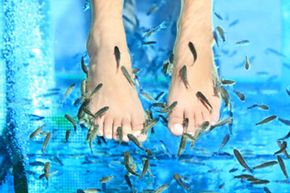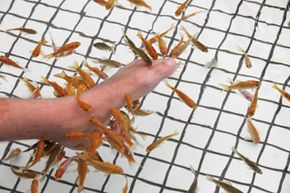Garra rufa fish are part of Cypriniformes family, found in Turkey, Syria, Iran and Iraq. Recently, due to fish pedicure popularity, Turkey has taken steps to ensure the fish are not overharvested. It's believed that the people of Turkey have been using garra rufa fish for healing purposes for at least 400 years. Besides the softening effect the fish have on the skin, people began to realize the fish provided relief from conditions such as psoriasis and eczema as well. Repeated doctor fish treatments showed healing for these patients.
Outside of Turkey, Asian countries began exporting the fish and opening salons and spas. Europe began picking up on the craze, and then the first garra rufa fish spa opened in the United States in Alexandria, Va., in 2008. Fish treatments have been popping up in spas all over the U.S. ever since.
The fish are moved from a communal tank to a personal footbath for each customer (each footbath is cleaned and sanitized between customers). About 100 fish go into each footbath at a time. Because no plant or aquatic life can really survive in the warm water in which the fish thrive, the fish have learned to eat whatever's offered to them -- including the dead skin on the bottom of your feet. In the wild, garra rufa survive by sucking the dead scales off other living fish, so perhaps sucking the dead skin off our feet isn't that much different.
Because the fish have no teeth, they are just nibbling and sucking at the dead skin. Without teeth, they can't remove live skin, so you don't have to worry about being bitten.



